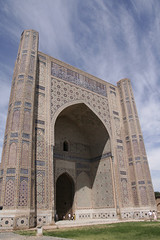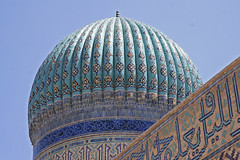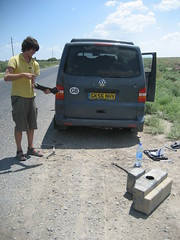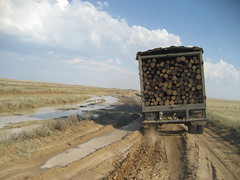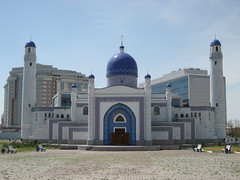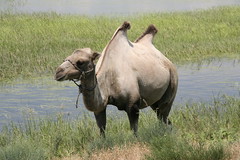Khorog - Pamir Highway
Hello Readers
Just a quick update from here as we are at a very slow internet cafe, in the town of Khorog in Tajikistan. We made it safely from Bukhara to Dushanbe with a relatively painless and friendly border crossing. We then managed to sort out our registration with the 'authorities' (to be done on pain of death round here) and collect our permits for the Pamir region from a dodgy guy called Dilshod. After a nice curry - probably our last restaurant for a while - we set off for the Pamir mountains; both excited about the fantastic scenery to come. The road soon heads into the mountains from Dushanbe and we found ourselves following a convoy of trucks over a 3250m pass, along a terrible road before dropping down into the Panj valley. The river Panj runs along the Tajik-Afghan border and we have been following it for 3 days now.
It is very interesting (and slighty scary) to see Afghanistan just the other side of the river and it is easy to see a massive difference between the Tajik housing and way of life spaced out along the Soviet-built tarmac road in contrast to the Afghan mud huts which are only accessible from a mountain path, which must be 100km long. Needless to say there are many, many Afghans patiently trekking from village to village on the other side with their donkeys in tow - vey odd to observe from the comfort of our Volkswagen.
We were delayed for a day at Wanch. We were about half way along the valley when we were told of a land slide up ahead. We had to sit out a day whilst they tried to sort it out. When we got there, it was less of a landslide and more of a 'Road falls into the river' situation, but the ingenious locals had managed to craft a route over the rocks which our van was (just) able to get over - accompanied by the cheers of many bemused locals.
We have been staying overnight with incredibly generous locals - we ask politely if we can park on their land to sleep and end up being invited in for dinner, music, local dancing etc. We have already been adopted by at least 3 Tajik families.
From here we now have to stock up with water and diesel before deciding whether to follow the main Pamir Highway up to Murghab or to take the longer route - continuing along the Afghan border down the Wakhan corridor which everyone has recommended to us as being fantastic (don't worry Mums - we are not going across the border and it is all very peaceful on the Afghan side - not much more than farmers and donkeys). Our main concern being that our visa dictates that we must leave on 30th June into Kyrgyzstan and it is very hard to get an accurate picture from anyone of what the road is actually like. We shall see.....
